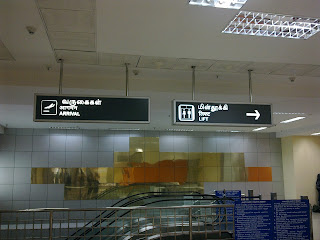Welcoming the world via elaborate airports is a new found fashion of every country. This is a trend one can notice today - in an era when a globalized economy seems to be the destiny of every nation and embracing a higher flux of people across its borders a desired consequence, reasons manifold.
With this as background, I happened to take a quick glance at a couple of Indian airports. In fact the following few illustrations are sequences one would commonly witness when passing through some of our country's airports and when flying in planes run by some of our airline companies. (Please note, I am referring to those airlines that are registered on Indian soil, and come under the purview of rules applying here.)
Ambient Language
While the ambiance and services an airport offers to its passengers could be a mere cosmetic artifact, the real charisma is embedded in the cultural richness the airport stands to represent, a culture the airport apparently opens doors to. Its an easy guess about the important role the ambient-language of the airport plays in making it this cultural tableaux.
The picture to the left illustrates two informative boards inside Chennai (Anna intl) Airport, marked significantly in the Tamil language (on top), followed by Hindi and English. Although the question about the need for three languages remains unasked here (too), common-sense seems to have prevailed though, clearly prioritizing communication in Tamil. This pattern of signage appears uniform across this airport making it clear that Tamil is the language that represents the culture of that land. This airport certainly has a bright future.. all such airports I mean.
On the other hand, the picture on the right taken in the new Bengaluru Intl Airport illustrates its dismal state of affairs when it comes to clarity in communication. Ambivalence and poor understanding of the real culture of Karnataka seems to be advertised shamelessly in every such placard inside BIA. Notice the clear difference in the sign-age methodologies between these two airports of neighboring states. Bengaluru being the capital of a Kannada state, this situation in BIA confuses the daylight out of its visitors with every such board!
More Confusion mid-air
Going ahead, this picture inside a plane further demonstrates how worse this confusion about language use (in a market) has become and how troubled and confused it leaves the common man participating in such markets. Consequence - this flight between Bengaluru and Chennai is evidently missing languages of both cities involved in this flight! Even here, English and Hindi swap positions between boards, reflecting the confusion even these airliners seem to be in when it comes to providing vital communication to passengers!
Why, I ask myself, does this confusion prevail in a market that has been functioning since longer than many other world markets. Let to itself, will our market not figure out which language is best placed in which market? Will the customers in those markets not want lesser confusion?! Who is voting confusion to rule here, after all? Let us find out...
(to be continued)
With this as background, I happened to take a quick glance at a couple of Indian airports. In fact the following few illustrations are sequences one would commonly witness when passing through some of our country's airports and when flying in planes run by some of our airline companies. (Please note, I am referring to those airlines that are registered on Indian soil, and come under the purview of rules applying here.)
 |
| Tamil comes first in Anna airport in Chennai |
While the ambiance and services an airport offers to its passengers could be a mere cosmetic artifact, the real charisma is embedded in the cultural richness the airport stands to represent, a culture the airport apparently opens doors to. Its an easy guess about the important role the ambient-language of the airport plays in making it this cultural tableaux.
The picture to the left illustrates two informative boards inside Chennai (Anna intl) Airport, marked significantly in the Tamil language (on top), followed by Hindi and English. Although the question about the need for three languages remains unasked here (too), common-sense seems to have prevailed though, clearly prioritizing communication in Tamil. This pattern of signage appears uniform across this airport making it clear that Tamil is the language that represents the culture of that land. This airport certainly has a bright future.. all such airports I mean.
 |
| Near invisible Kannada on boards in Bengaluru Intl airport |
More Confusion mid-air
 |
| In-flight directions - a rather risky confusion this! |
Why, I ask myself, does this confusion prevail in a market that has been functioning since longer than many other world markets. Let to itself, will our market not figure out which language is best placed in which market? Will the customers in those markets not want lesser confusion?! Who is voting confusion to rule here, after all? Let us find out...
(to be continued)
Very unfortunate, not sure why no one in karnataka understands this simple concept except few of us. Hope everyone gets this soon. Nice post.
ReplyDeletenice post with appropriate pics ...
ReplyDelete